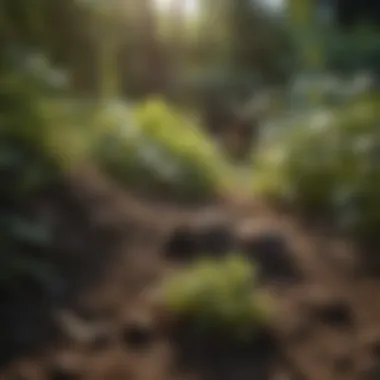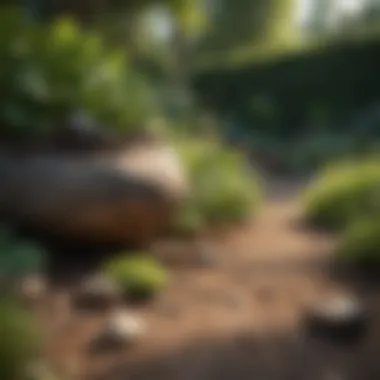Effective Strategies to Eliminate Moles from Your Garden


Intro
Moles can cause significant damage to gardens. Their tunneling behavior disrupts soil structure, uproots plants, and creates unsightly mounds. This article aims to provide a thorough understanding of effective strategies to manage moles in your outdoor spaces. The focus is not just on elimination but also on sustainable practices that align with gardening principles.
Understanding the habits of moles is vital. Moles are primarily focused on hunting for food, which includes insects and earthworms. By recognizing their patterns, homeowners can take informed steps to mitigate the problem. Additionally, this article discusses both chemical and natural solutions, making it suitable for various gardening philosophies.
The strategies outlined here are designed to suit not only enthusiasts but also those seeking to maintain the integrity of their garden ecosystems. By balancing elimination with prevention, gardening aficionados will find a holistic approach to dealing with moles.
Key points to explore in this article include:
- Understanding mole behavior and impact
- Natural solutions that deter moles
- Chemical methods that provide results
- Preventive measures to keep moles away
- Best practices for sustainable gardening
Ultimately, the goal is to equip you with the knowledge and tools you need to effectively manage moles in a way that preserves the beauty and functionality of your garden.
Understanding the Mole Problem
Understanding the mole problem is crucial for any gardener. Moles may seem harmless, but they can cause significant damage to gardens. Recognizing their behavior and habits helps in devising effective strategies for control.
Moles play an essential role in the ecosystem. However, an overpopulation in your garden can lead to problems such as uprooted plants and disrupted soil.
The Role of Moles in Ecosystems
Moles contribute to soil aeration and pest control. Their tunneling processes improve oxygen flow to the soil, which can enhance plant growth. Furthermore, they feed on harmful insects like grubs and beetles, keeping pest numbers in check. Despite these beneficial roles, excessive mole activity can undermine plant health, leading to an imbalance in the garden’s ecosystem.
Reasons for Mole Infestation
Food Sources
Moles primarily dig in search of food. Their diet includes earthworms and grubs, which are generally abundant in rich soils. The availability of these foods makes gardens attractive to moles. If your garden is lush with these food sources, it might encourage mole habitation. This characteristic is essential to consider when trying to control moles, as removing food sources is one method to deter them.
Soil Conditions
Moist and soft soil conditions attract moles. They prefer environments easy to tunnel through, which often are found in gardens with good drainage. The presence of organic materials and a high moisture content often make soil conditions ideal for moles. Therefore, understanding soil quality in your garden is vital for addressing mole issues.
Garden Layout
The layout of your garden can also influence mole activity. Areas with abundant vegetation or garden beds are often appealing spots for moles to burrow. If there's minimal disturbance, such as constant foot traffic, moles may feel more at home. Designing your garden with sporadic disturbances can make it less appealing to them.
Identifying Signs of Moles
Recognizing early signs of mole activity helps in prevention and management. Common signs include:
Mole Hills
Mole hills are a clear indication of their presence. These small mounds of soil result from tunneling and can disrupt the aesthetics of your garden. Noticing mole hills can prompt immediate action to curb their spread, as they usually mark active tunneling areas.
Burrow Entrances
The entrances to a mole’s burrow are often small, round openings. Observing these sites can indicate active or inactive burrows. Identifying these can guide you on where to place traps or deterrents.
Surface Tunnels
Surface tunnels create shallow pathways across your garden. These paths are typically raised above the ground. Monitoring these tunnels can help you track mole activity and focus your control measures more effectively.
Understanding the behavior and signs of moles can greatly aid in developing a strategic approach to managing them in your garden.
Evaluating the Impact of Moles
Understanding the impact of moles in gardens is essential for creating balanced ecosystems. Moles can influence both soil health and garden aesthetics. Evaluating their role adds depth to the strategies used for control. Some may see them solely as pests, but their contributions to soil structure and pest management deserve exploration. Thus, this assessment helps homeowners make informed decisions and foster an environment that is favorable for plants.
Positive Effects of Moles
Soil Aeration


Soil aeration is a significant benefit provided by moles. As moles tunnel through the ground, they create spaces in the soil. This process allows air, water, and nutrients to penetrate deeper, improving overall soil health. Healthy soil promotes better root growth, which is vital for robust plant development. Therefore, the unique feature of soil aeration enabled by moles is how it enhances the biological activity within the soil, ultimately benefiting the entire garden ecosystem.
Pest Control
Another positive aspect of moles is their role in pest control. Moles consume various insects, grubs, and potentially harmful pests. By maintaining a balance within the underground food web, they can reduce the likelihood of pest outbreaks that could harm garden plants. Thus, their voracious appetite for pests makes moles a popular choice for organic pest management. The unique feature here is that they can help balance populations of common garden pests, which can have long-term benefits.
Negative Effects on Gardens
Damage to Roots
While moles can positively impact soil and pest regulation, they can also cause notable harm to gardens. They tunnel below the surface and may inadvertently damage plant roots. This root damage can lead to yellowing foliage, stunted growth, or even the death of plants. The key characteristic of this damage is that it directly undermines the plants' structural integrity, which is crucial for their health. Homeowners must recognize this downside when considering mole management options.
Surface Disruption
Surface disruption is another negative effect caused by moles. Their tunneling activity creates unsightly mounds of soil, often referred to as molehills. These mounds can be considered a nuisance in lawns and flower beds, disrupting the aesthetic appeal of the garden. The unique feature here is that the proliferation of surface disruptions can lead to uneven ground, potentially creating hazards for pedestrians and damaging mowing equipment.
Impact on Aesthetics
Lastly, moles can significantly impact the aesthetics of a garden. The presence of their tunnels and molehills can make a meticulously maintained garden appear disheveled and unkempt. Homeowners often prioritize the visual aspects of their outdoor spaces, making this a notable concern. The key characteristic of this impact is that it may influence perceptions of garden care and maintenance, leading to potential feelings of frustration or embarrassment among garden enthusiasts.
"Understanding both the benefits and drawbacks of moles helps gardeners to make informed decisions about their management."
Natural Methods to Deter Moles
Natural methods to deter moles are essential for those who prefer a non-invasive approach to garden management. These strategies focus on leveraging natural substances and ecological balances to reduce mole populations. By understanding the benefits and implications of these methods, homeowners can maintain a healthy garden ecosystem without resorting to harmful chemicals. The primary advantage is that these methods often promote a more sustainable gardening practice while being safe for other native wildlife.
Using Deterrents
Essential Oils
Essential oils can be effective in repelling moles due to their strong scents. Oils like peppermint and spearmint are particularly popular. Their key characteristic is that they are potent and can interfere with a mole's sense of smell, making the area less inviting. One benefit of using essential oils is that they are entirely natural, making them a safer choice for gardeners concerned about chemicals. However, the unique feature of essential oils is that they may require frequent reapplication, especially after rain. This could make them less practical for some, yet their organic nature is a significant advantage.
Cayenne Pepper
Cayenne pepper serves as another deterrent due to its spicy fragrance. The key characteristic of cayenne is its heat, which moles dislike. It is a popular choice for gardeners looking for a simple and inexpensive solution to deter moles. When sprinkled in areas where moles are active, it creates an unpleasant environment for them. However, cayenne pepper, like essential oils, loses its potency over time and may also wash away with rainfall. Therefore, reapplication is necessary which can involve additional effort.
Castor Oil
Castor oil is well-regarded for its ability to repel moles effectively. Its specific aspect lies in the fact that it creates an unpleasant taste and smell for moles, discouraging them from the treated area. The key characteristic of castor oil is its thick consistency, making it easy to mix with water for application in burrows. This oil is a beneficial option because it is not only effective against moles but also benign to most plants. However, a disadvantage can be its somewhat slippery nature, which can sometimes create challenges in application stability.
Encouraging Natural Predators
Owls
Owls play a significant role in controlling mole populations naturally. Their presence in a garden can serve to keep moles away. A key characteristic of owls is their proficient hunting skills. By providing suitable habitats, such as owl boxes, you can attract these birds to your property. The main advantage here is that it contributes to a balanced ecosystem, promoting biodiversity. However, the unique feature is that it may take time for owls to adjust to the area, meaning immediate results should not be expected.
Snakes
Snakes can also help manage mole numbers. They contribute to the ecosystem by preying on moles in your garden. The key characteristic of snakes is their ability to hunt efficiently in underground tunnels. This offers a beneficial solution without using chemicals or traps. However, it’s vital to note that not all snakes are beneficial, as some may pose a risk to pets or children. Understanding local snake species is essential to ensure the safety of your garden.
Implementing Physical Barriers
Underground Fencing
Underground fencing can be a highly effective strategy to deter moles. This method involves installing a durable barrier that extends below the soil surface. The key characteristic of this fencing is that it prevents moles from accessing the garden area. It is a beneficial choice because it provides a long-term solution to mole infiltration. However, the unique feature of underground fencing is the labor-intensive installation process, which can deter some homeowners. Still, once established, it can offer peace of mind.
Wire Mesh Techniques
Wire mesh techniques can discourage moles from entering specific garden sections. The wire mesh is laid down beneath the soil to create a physical barrier against burrowing. The key characteristic is that this method works for various garden layouts and sizes. Opting for this approach is advantageous as it can protect young plants from root damage. A disadvantage is the need for proper installation to be effective, which might require additional time and effort from the gardener.
Chemical Solutions for Mole Control
Chemical solutions play a significant role in managing mole populations in gardens. While many homeowners prefer natural methods, the use of chemicals can offer quicker results and sometimes broader coverage against moles. Chemical solutions include repellents and pesticides designed specifically to target moles. Understanding the effectiveness of these options can guide gardeners in making informed decisions about their pest control strategies. Moreover, it is crucial to balance these methods with environmental considerations to prevent unintended consequences.


Overview of Chemical Repellents
Chemical repellents are substances that deter moles from specific areas. These products typically contain compounds that emit strong scents or tastes unfavorable to moles. While their effectiveness can vary, using repellents instead of lethal means can align better with sustainable gardening practices. Homeowners often appreciate this approach as it allows for coexistence with wildlife.
Some common chemical repellents include:
- Castor oil: Known for its strong scent, moles are less likely to burrow in treated areas.
- Essential oils: Mixtures like peppermint or citronella also act as repellents, disrupting the mole’s sense of smell.
It is essential to apply these repellents generously and follow specific instructions to get the best outcomes.
Pesticides and Their Effectiveness
Pesticides designed for mole control can be effective for reducing populations. They are formulated to target moles specifically, disrupting their activities in the garden. However, one must consider the application methods, timing, and potential fallout of using such chemicals. This knowledge helps ensure the tactics taken do not harm the garden or surrounding ecosystem.
The effectiveness of pesticides often depends on:
- Application timing: Treating during peak activity periods can yield better results.
- Soil conditions: Some pesticides may require specific conditions for optimal performance.
While these products can be notable in controlling the mole population effectively, over-reliance on them can lead gardeners to miss out on sustainable practices.
Environmental Considerations
When discussing chemical solutions, it is essential to take into account their environmental impact. Two significant aspects to consider are the effects on non-target species and the residual impact on soil health.
Effects on Non-target Species
The application of chemicals can have unintended consequences on other wildlife. Non-target species, such as beneficial insects and small mammals, may also be affected by the chemicals intended to eliminate moles. This can disrupt the ecological balance, leading to more problems in the garden. When selecting products, it is important to consider minimal impact on these species. A careful approach ensures the preservation of beneficial organisms crucial for maintaining a healthy garden ecosystem.
Residual Impact on Soil Health
Chemicals used in pest control might leave residues that could affect the soil quality over time. Residual impacts can alter the balance of microorganisms essential for soil fertility. Many gardeners aim to keep their soil healthy for optimal plant growth and long-term sustainability. Thus, selecting pesticides that degrade rapidly and do not accumulate is essential to avoid compromising soil health.
In summary, while chemical solutions can be effective in managing mole populations, it is crucial to approach them with a balanced perspective. This ensures that the overall health of the garden and its surrounding environment remains preserved. Gardeners are encouraged to integrate these methods with natural tactics to create a more holistic approach.
Trapping Techniques
Trapping techniques represent a significant approach to managing mole populations effectively. These methods focus on physically capturing moles rather than relying solely on chemical or natural deterrents. Understanding the nuances of trapping can lead to more successful outcomes and minimize the potential for harm to your garden's ecosystem. It is essential to choose the right traps and implement effective strategies, as improper handling might result in aversion or failure.
Choosing the Right Trap
Types of Traps
When evaluating the types of traps available, there are primarily three categories: scissor traps, harpoon traps, and tunnel traps. Each type has distinct characteristics and benefits. Scissor traps are popular because of their effectiveness in directly killing moles. They work on the principle of swiftly cutting through the animal. Harpoon traps, on the other hand, penetrate the mole, ensuring a quick end. Tunnel traps capture moles without causing death, making them a humane choice.
A key characteristic of these traps is their design. Effective traps must match the mole’s tunnel size for optimal results. This ensures engagement and minimizes the chance of the mole escaping. Among these, scissor traps may be the most beneficial for home users due to their straightforward installation and proven outcomes.
However, it is vital to consider the drawbacks as well. Scissor traps can sometimes be inhumane, causing unnecessary suffering. If opting for harpoon traps, one must handle them carefully to avoid accidental harm to non-target species.
Trap Placement Strategies
Effectively placing traps increases the likelihood of successful capture. Placing traps in locations where moles regularly tunnel can make all the difference. One key characteristic of trap placement is identifying active burrows. These active sites often display fresh dirt and new tunnel openings.
The unique feature of strategic trap placement aligns with the biology of moles. These animals tend to follow established pathways, making it easier for traps to work effectively. Utilizing multiple traps in highly active areas can significantly enhance your success rate.
However, one must also be cautious about the overall garden ecosystem. Excessive trapping can disrupt the local wildlife and may lead to unintended consequences. Therefore, it is crucial to monitor the effectiveness of your selected locations.
Proper Trapping Protocols
Proper trapping protocols ensure safety and increase effectiveness. Always follow the manufacturer's instructions for setting traps to avoid malfunction. Clean the area around the trap to ensure that no foreign scents diminish its efficacy. Also, check traps regularly to minimize suffering for captured moles and to assess the success of your strategies.
Humane Considerations
Considering humane aspects while managing moles is vital, not only for ethical concerns but also for maintaining balance in the garden. Choose traps that allow for the capture of moles without inflicting lasting harm. Some traps designed for humane capture enable the release of moles unharmed, allowing homeowners to relocate them safely.


Engagement with local wildlife organizations for relocation options is advisable, as many regions have specific regulations about trapping and relocating wildlife. Adhering to humane considerations while trapping not only reflects responsible gardening practices but also cultivates a respectful relationship with nature.
Maintenance and Prevention Strategies
Maintaining a healthy garden ecosystem requires proactive measures. Prevention strategies play a crucial role in minimizing mole presence. By focusing on factors that contribute to their habitat, gardeners can create an inhospitable environment that discourages mole activity. Consistent maintenance practices not only help in mole control but also support the overall health of the garden. This section will cover key methods to achieve effective mole management through maintenance and prevention.
Maintaining Healthy Soil
Healthy soil forms the foundation of any thriving garden. This health is vital because it directly influences the presence of moles. Two significant aspects of maintaining soil health are compaction relief and proper drainage.
Compaction Relief
Soil compaction occurs when soil particles are pressed together, reducing air spaces. This condition may make the soil attractive for moles, as it leads to fewer earthworms and other beneficial organisms. Thus, relieving compaction can deter moles by making the soil less desirable. This is beneficial for any gardener wishing to maintain a low mole population.
One effective method for compaction relief is using aeration tools. These tools create holes in the soil, promoting better air flow and water penetration. The unique feature of this method is its dual purpose; it not only hinders mole activity but also enhances the vitality of plants. However, it can be labor-intensive and might require scheduling during specific growth periods to avoid disrupting plant roots.
Proper Drainage
Proper drainage is another essential element of soil health. Moles typically thrive in wet or saturated soil as it attracts their primary food sources, such as earthworms. By ensuring efficient drainage, you make your garden less appealing to these creatures.
One way to establish proper drainage is to incorporate organic matter into the soil. This practice improves soil structure and allows water to flow more freely. The benefits of proper drainage include healthier plants and decreased likelihood of mole infestations. However, this may require initial effort and expense, especially when installing drainage systems.
Creating Inhospitable Environments
To further prevent moles from taking residence, it is key to create inhospitable environments. This approach involves a combination of garden design and maintenance. For instance, removing excess thatch and actively managing insect populations can reduce food sources available to moles. Additionally, ensuring the garden area has low moisture levels discourages their activity.
Timing and Seasonal Management
Monitoring your garden during key growth cycles is critical. Awareness of when moles are most active allows homeowners to implement preventative measures effectively. Seasonal adjustments should also be considered.
Monitoring During Growth Cycles
Monitoring during growth cycles allows gardeners to observe when mole activity peaks. This timing can inform interventions, such as adjustments in watering or soil health management. Early detection of mole activities helps in strategizing effective responses, creating a more resilient garden.
Seasonal Adjustments
Seasonal adjustments, like modifying planting times or professional treatments, can be crucial in maintaining control over mole populations. Adjustments based on the seasons not only prevent moles but also promote thriving plant environments. These changes should be carefully assessed to maximize benefits while minimizing disturbance to plants.
In summary, effective maintenance and prevention strategies can significantly minimize the chances of moles infesting your garden. It involves understanding soil health, timely interventions, and creating environments that are not conducive to moles.
End and Best Practices
In the pursuit of eliminating moles from your garden, understanding effective strategies is not just beneficial; it is essential. This final section synthesizes the insights gained throughout the article, providing a roadmap for successful mole management. The strategies discussed are designed to blend efficiency with environmental consciousness.
Implementing the correct approach offers several key benefits. First, it helps preserve the health of the garden ecosystem. Consider the balance between controlling unwanted pests and maintaining helpful species. Second, it enhances the aesthetic appeal of your outdoor space. A well-managed garden, free from disruptive mole activity, reflects care and attention to detail. Lastly, adopting these best practices could save time and resources in the long term, allowing for a more enjoyable gardening experience.
Summarizing Effective Strategies
To effectively deter moles, several strategies stand out. These include:
- Natural Deterrents: Utilizing essential oils, cayenne pepper, and castor oil can create a less inviting environment for moles without harming other wildlife.
- Encouraging Predators: Attracting natural enemies such as owls and snakes can help keep the mole population in check.
- Physical Barriers: Installing underground fencing or utilizing wire mesh can prevent moles from entering the garden.
- Chemical Solutions: When necessary, using chemical repellents carefully can provide immediate relief, though these require cautious application to avoid affecting non-target species.
- Trapping: Employing traps with appropriate placement can effectively reduce mole numbers if the previous strategies do not work.
These strategies offer a multifaceted approach to mole control and should be adapted based on individual circumstances.
Future Considerations in Mole Management
Looking ahead, considerations for mole management will continue to evolve. As urban areas expand and human activity continues to influence wildlife habitats, moles may adapt to new environments. Homeowners must stay informed about changing behaviors and potential challenges.
Researching and understanding local ecosystems can provide insights into effective management. Programs focused on conservation often emphasize understanding wildlife dynamics. The integration of technology, like motion sensors, can offer innovative solutions for monitoring mole activity.
Encouraging Environmental Balance
An essential component of mole management is promoting a balanced ecosystem. Moles play a role in soil aeration and pest control, contributing positively to garden health. Therefore, the goal should not merely be elimination but rather finding harmony.
Strategies to encourage this balance include:
- Creating habitats that support natural predators.
- Maintaining healthy soil that promotes beneficial microorganisms.
- Considering the role of plants that deter pests naturally without harming other beneficial species.
By fostering an environment that allows for coexistence, you not only protect your garden but also contribute to the broader ecological health of your area. Achieving this balance requires more than information; it demands action, observation, and adaptation.















